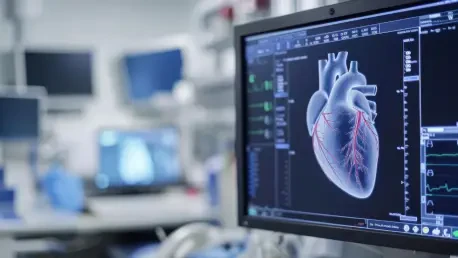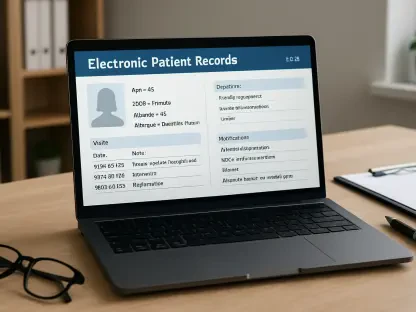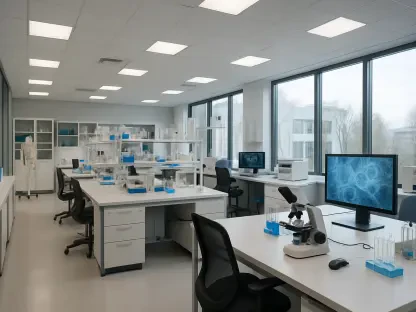Recent advancements at the University Hospitals Harrington Heart & Vascular Institute have propelled cardiac imaging into a new era, highlighting the significant role of Flyrcado™ (flurpiridaz F 18) in streamlining the diagnosis process for coronary artery disease (CAD). As the leading cause of heart attacks, CAD demands precise diagnostics to effectively address patient needs. Flyrcado, now a cornerstone technology in Ohio and the first of its kind implemented in the state, underscores a shift toward more accurate and accessible diagnostic solutions. The increased precision and accessibility of positron emission tomography (PET) myocardial perfusion imaging (MPI) promise game-changing impacts on the diagnosis and treatment of heart diseases.
Revolutionizing Diagnostic Approaches
Enhanced Accuracy of Cardiac Stress Testing
The implementation of Flyrcado marks a watershed moment in cardiac stress testing by offering clinicians the ability to obtain more accurate images of heart perfusion. This capability is crucial for diagnosing CAD and evaluating its severity. Accurate imaging allows healthcare professionals to closely analyze the patterns of blood flow and identify any blockages within the coronary arteries. Such detailed insights enable a more comprehensive understanding of a patient’s cardiac condition, paving the way for better treatment strategies. The precision of Flyrcado, exceeding that of traditional diagnostic methods, represents a substantial boost to cardiac care by integrating state-of-the-art imaging into standard medical practice.
Incorporating Flyrcado into clinical settings not only improves diagnostic accuracy but also optimizes patient outcomes. The advanced imaging capabilities reduce ambiguity in diagnosis, ensuring that medical interventions, like stenting or bypass surgery, are informed by precise data. This reduction in guesswork significantly benefits patient prognosis while potentially saving lives through timely and accurate treatment plans. By emphasizing sophisticated PET MPI techniques, healthcare facilities can foster an environment of excellence in cardiology, thus positioning themselves at the forefront of medical innovation.
Expanding Access to Advanced Imaging
Flyrcado’s distinctive feature—a longer half-life compared to existing tracers—facilitates more widespread distribution of advanced imaging services. This factor allows smaller and regional medical centers to access leading-edge diagnostic technologies traditionally limited to large hospital facilities. The benefits of centralized manufacturing, enabled by Flyrcado, mean that advanced cardiac diagnostics need no longer be constrained by geographic or logistical barriers, thus making high-quality cardiac care more accessible to diverse populations across Ohio. This widespread accessibility reduces inequalities in healthcare and ensures that all patients have the opportunity to receive timely and accurate cardiac assessments.
Moreover, the integration of Flyrcado into medical practices introduces a wave of innovation that seeks to bridge the gap between cutting-edge technology and community health needs. The availability of PET MPI beyond major cities challenges the norm, encouraging a more equitable distribution of healthcare resources. As smaller centers adopt these technologies, patients in previously underserved areas gain access to high-tech diagnostics and expert cardiology, empowering healthcare providers to deliver superior care regardless of location. This paradigm shift could potentially reform the healthcare landscape by standardizing top-tier medical practices.
Unearthing New Horizons in Cardiac Care
Comprehensive Efforts in Implementation
The adoption of Flyrcado is part of a broader initiative by the University Hospitals’ cardiology and radiology departments to harness advanced nuclear cardiology solutions. The innovative radiopharmaceutical’s development is a testament to the institute’s commitment to pioneering treatments that tackle the complexities of heart disease. By addressing limitations in the availability of PET MPI, Flyrcado aligns with the strategic goals of broadening the scope of advanced diagnostics and ensuring they are within reach of a wider range of healthcare settings. This approach not only optimizes clinical operations but also enhances collaboration between specialists in cardiology and radiology to achieve superior outcomes.
Further, the specialists’ shared enthusiasm highlights a synergistic approach in integrating Flyrcado within existing frameworks. As leaders in cardiac care, they play an instrumental role in leveraging this technology to its fullest potential, ensuring that the nuances of each patient’s condition are meticulously considered. This concerted effort in adoption reflects a forward-thinking strategy to enhance diagnostic precision while elevating overall standards of care. The collaborative insights generated by using Flyrcado drive continuous improvements and reinforce the institution’s reputation as a leader in cutting-edge medical practices.
Advancing Patient Outcomes
The integration of Flyrcado into routine cardiac MRI and PET MPI tests fosters not only technical innovation but also tangible improvements in patient care pathways. The application of this technology permits clinicians to make well-informed decisions, significantly reducing the uncertainty associated with conventional diagnostic methods. The resultant clarity in patient diagnosis and treatment plans enhances confidence among both healthcare providers and patients, contributing to better health outcomes and improved patient satisfaction. This commitment to utilizing advancements in medical imaging underscores a patient-centric approach, ensuring that each individual receives tailored, high-quality care designed to meet their specific health requirements.
By paving the way for refined diagnostic capabilities, Flyrcado encourages a reevaluation of current medical practices concerning cardiac health. This shift not only transforms patient experiences but also exemplifies the potential of technology-driven improvements in healthcare. As the integration of Flyrcado continues to mature, healthcare providers are poised to explore new possibilities in cardiac diagnostics, embodying a proactive approach to tackling heart disease head-on. The anticipated proliferation of Flyrcado within the University Hospitals network signifies a transformative step to elevate overall standards in cardiac care delivery.
The Road Ahead for Cardiac Diagnostics
Recent developments at the University Hospitals Harrington Heart & Vascular Institute have significantly advanced cardiac imaging, ushering in a new era for diagnosing coronary artery disease (CAD). Flyrcado™ (flurpiridaz F 18) has become essential in streamlining the CAD diagnosis process. As the leading cause of heart attacks, CAD requires precise and efficient diagnostics to cater to patients’ needs effectively. Flyrcado, now a pivotal technology in Ohio, marks the first implementation of its kind in the state, representing a major shift towards more precise and accessible diagnostic methods. This advancement reflects a broader trend toward innovating diagnostic solutions. The enhanced accuracy and availability of positron emission tomography (PET) myocardial perfusion imaging (MPI) promise transformative impacts on diagnosing and treating heart diseases. Such technological progress not only improves patient outcomes but also shapes the future landscape of cardiac care by offering deeper insights and more reliable diagnostic capabilities.









